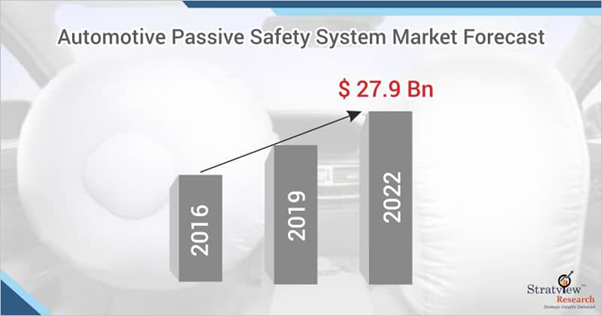Automotive safety has come a long way over the years, with advancements in both active and passive safety systems. Among these, passive safety systems have played a crucial role in protecting occupants during accidents. These systems have continuously evolved to enhance vehicle safety, incorporating innovative technologies and engineering techniques.
According to Stratview Research, the automotive passive safety system market is projected to grow at a sustainable CAGR of 3.7% over the next five years to reach US$ 27.9 billion in 2022.
Early Passive Safety Measures
In the early days of the automotive industry, safety features were limited. Vehicles were built with sturdy frames and simple seat belts, offering minimal protection during collisions. However, as the need for enhanced safety became evident, engineers started developing more sophisticated passive safety measures.
Seat Belt Innovations
The seat belt has been one of the most significant advancements in automotive safety. Early seat belts were basic lap belts, but they were later upgraded to three-point seat belts, consisting of a lap belt and a shoulder belt. This design significantly reduced the risk of injury by distributing the crash forces over a larger area and restraining occupants more effectively.
Airbags and Supplemental Restraint Systems
The introduction of airbags revolutionized automotive safety. Initially, airbags were only installed for frontal impacts, but their scope expanded to include side-impact and curtain airbags. Modern vehicles now feature comprehensive Supplemental Restraint Systems (SRS) that deploy multiple airbags and use sensors to detect the severity of an impact, enabling tailored protection for occupants.
Structural Enhancements
Passive safety systems have also focused on improving vehicle structures to better absorb and distribute crash forces. Crumple zones were introduced, designed to absorb energy during a collision by deforming in a controlled manner. This helps reduce the impact transferred to the occupants' compartments. Stronger materials, such as high-strength steel and aluminum alloys, have been incorporated into vehicle designs, providing increased structural integrity.
Advanced Safety Technologies
With the advent of advanced technologies, automotive passive safety systems have reached new heights. Here are some notable advancements:
· Electronic Stability Control (ESC): ESC systems continuously monitor vehicle behavior and apply selective braking to individual wheels to prevent skidding and loss of control. This technology has significantly reduced the risk of accidents, particularly during sudden maneuvers or adverse road conditions.
· Pre-Collision Systems (PCS): Using sensors and cameras, PCS detect potential collisions and can activate various safety measures, such as automatic braking and tightening seat belts. These systems help prevent accidents or reduce the severity of impacts by warning drivers or autonomously intervening when necessary.
· Active Headrests: Active headrests move forward during a rear impact to reduce the risk of whiplash injuries. They provide better support to the head and neck, mitigating the effects of a collision.
Conclusion
The evolution of automotive passive safety systems has revolutionized vehicle safety, significantly reducing the risk of injuries and fatalities. From humble beginnings with basic seat belts to the integration of advanced technologies, automotive manufacturers have made remarkable progress in enhancing passive safety measures.
Today, vehicles are equipped with comprehensive systems, including advanced airbags, reinforced structures, and electronic aids like ESC and PCS. These innovations have not only increased occupant protection but also helped create a culture of safety on the roads.
However, the quest for safer vehicles continues. As technology advances, we can expect further improvements in automotive passive safety systems, including the integration of artificial intelligence, enhanced sensor technologies, and the development of autonomous vehicles that prioritize safety.
Ultimately, the evolution of automotive passive safety systems is an ongoing journey, aimed at ensuring that every occupant is protected to the highest possible degree. Through continued research, innovation, and collaboration across the automotive industry, we can look forward to a future where accidents are minimized, and our roads become






Comments